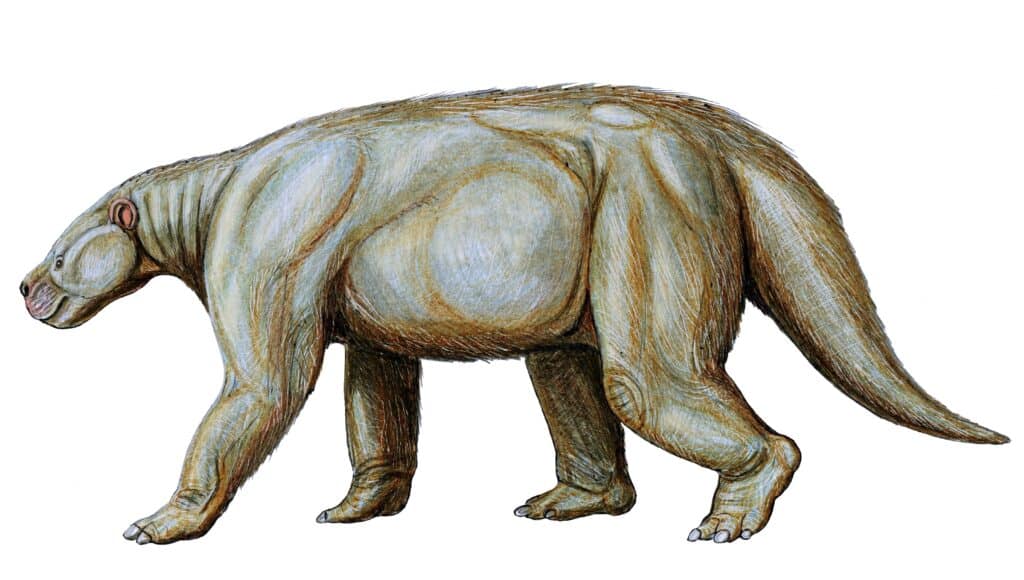Barylambda was one of the largest animals that lived during the Paleocene
Advertisement
Barylambda Scientific Classification
- Kingdom
- Animalia
- Phylum
- Chordata
- Class
- Mammalia
- Order
- Cimolesta
- Family
- Barylambdidae
- Genus
- Barylambda
- Scientific Name
- Barylambda faberi
Read our Complete Guide to Classification of Animals.
Barylambda Conservation Status

Barylambda Facts
- Fun Fact
- Barylambda was one of the largest animals that lived during the Paleocene
- Biggest Threat
- Competition from other herbivores such as Coryphodon
- Most Distinctive Feature
- Barylambda had massive bear-like legs with five toes
- Distinctive Feature
- Barylambda had a small head
- Habitat
- Swampy plains
- Diet
- Herbivore
- Type
- Extinct pantodont mammal
- Special Features
- Barylambda had a thick and heavy tail.
- Origin
- North America
- Number Of Species
- 3
View all of the Barylambda images!
Barylambda is an extinct genus of unusual-looking mammal that lived in North America during the Late Paleocene Epoch, between 58.7 and 55.8 million years ago. It was a heavily-built herbivore that lived on soft vegetation. Barylambda was one of the largest animals that lived during the Paleocene. Although it was a herbivore with very limited defensive mechanisms, the size of this animal would have protected it from predators.
Description and Size

Heavily-built animals like the Barylambda were typically herbivores. In addition to this, scientists concluded that this animal most likely fed on plants based on their general dentition and the absence of shearing blades on their molars.
©5,792 × 3,283 pixels, file size: 1.64 MB, MIME type: image/jpeg – License
Barylambda is a genus of pantodont mammal that lived from the Middle to Late Paleocene, about 58.7 to 55.8 million years ago. Pantodonts are a group of heavily-built mammals closely related to present-day placental mammals. Three species are currently recognized in the Barylambda genus.
Pantodonts are heavy-set animals, and the Barylambda was not an exception. It was larger than most of the other pantodonts that lived at the time, making it one of the largest land animals of the Paleocene. This five-toed beast had a body structure similar to modern-day tapirs or rhinoceros. There’s also a chance it may have looked a lot like a large ground sloth, with its small head with massive bear-like legs. It also had a thick and heavy tail. Experts think the animal might have used this tail to support its weight when it raises itself on its hind legs.
Barylambda was roughly the size of a horse as we know it. It weighed about 1433 pounds and was about eight feet in length. In a quadrupedal stance, this animal stood at about five feet tall at the shoulders. Barylambda had a plantigrade locomotion, meaning it walked with all its toes and metatarsals fully flat on the ground.
History and Evolution
Barylambda belonged to a group of mammals (pantodonts) that rose to prominence shortly after the Cretaceous extinction event. This group of mammals didn’t just appear after the Cretaceous-Paleogene extinction event; they lived alongside the dinosaurs but remained relatively small and shrew-like when the bigger dinosaurs were around.
The pantodonts survived the mass extinction event and went on to evolve into much bigger sizes. Barylambda was one of the largest land animals of its time and one of the largest pantodonts to ever evolve. Barylambda had clavicles (collarbones), a feature that experts consider primitive in hoofed mammals. As time progressed, bigger pantodonts evolved that would eventually displace the Barylambda from their typical ecological position.
Diet — What Did Barylambda Eat?
Heavily-built animals like the Barylambda were typically herbivores. In addition to this, scientists concluded that this animal most likely fed on plants based on their general dentition and the absence of shearing blades on their molars.
Judging by the level of wear on their teeth, experts think Barylambda most likely fed on soft vegetation that was easy to chew. The animal was probably capable of rearing itself up temporarily on its hind legs as modern-day bears do. This would have made it easier to reach foliage on top of trees and shrubs.
Habitat — When and Where It Lived
Barylambda lived for a very short time during the Paleogene Epoch. More specifically, it was around for about three million years during the Late Paleocene Epoch (around 58.7 to 55.8 million years ago).
Fossils of this animal are mainly found in North America (specifically Colorado and Wyoming). The exact nature of their home habitat is not known. However, studies that explore the nature of the formations where the fossils were found suggest that they lived during a period of globally-high temperatures.
Paleontologists have also found multiple tracks that belonged to the Barylambda in restricted marine deposits. This means that the animal repeatedly walked across fully submerged or partially emergent tidal flats. The evidence suggests that Barylambda lived in swampy plains close to (and may have interacted with) a marine ecosystem. It probably lived like modern hippopotami, with the animal spending most of its day in swamps with abundant soft vegetation to feed on.
Threats and Predators
With a weight of more than 1400 pounds and such a sheer size, this alone would have protected it from any of the carnivores that lived in its area. There weren’t a lot of predators, to begin with, and none of them was big enough to take on this animal. This explains why the genus was so successful during the time it was around. However, as time progressed, larger pantodonts, such as the Coryphodon evolved. The slightly smaller Barylambda constantly faced competition for food and space from this animal and their other pantodont relatives.
Discoveries and Fossils — Where Barylambda Was Found
Barylambda was described for the first time in 1937. The animal is well-known from fossils that paleontologists recovered from the DeBeque Formation in Colorado and the Clarkforkian Wasatch Formation in Wyoming.
The first species ever described in this genus was the Barylambda faberi. Paleontologists found “this fossil in” the “Plateau Valley” beds in Wyoming that date back to the Paleocene-Eocene epochs. Barylambda was the first pantodont identified in North America.
Extinction — When Did Barylambda Die Out?
Barylambda was around for a relatively short period of time. It eventually went extinct during the Late Paleocene Epoch about 55 million years ago. Experts think the emergence of larger and more specialized terrestrial herbivores (notably the closely-related Coryphodon) may have contributed to the disappearance of this genus.
Similar Animals to the Barylambda
Similar dinosaurs to the Barylambda include:
- Coryphodon — Like the Barylambda, Coryphodon was a pantodont with a similar appearance. However, it was slightly bigger. Experts think the emergence of the Coryphodon to Barylambda’s disappearance.
- Bemalambda — This is a genus of pantodont mammal that lived in China around the same period as the Barylambda in America. It was about the size of a large dog and was either a herbivore or an omnivore.
- Titanoides — This is an extinct genus of pantodont mammals from North America. It was roughly the same length as the Coryphodon but slightly smaller in terms of body mass. The Titanoides were among the largest mammals in their habitat.
Related Animals
View all 285 animals that start with BBarylambda FAQs (Frequently Asked Questions)
When was the Barylambda alive?
Barylambda lived in North America during the Middle to Late Paleocene Epoch. This was between 58 and 55 million years ago. It eventually went extinct about 55 million years ago.
How big was Barylambda?
Barylambda was a relatively bulky animal. It was about eight feet long and five feet tall at the shoulders. This massive beast weighed about 1433 pounds on average.
What did Barylambda eat?
Barylambda was an herbivore. The nature of their dentition suggests that the animal most likely fed on soft vegetation that was easy to chew. It could stand upright on its hind feet to eat foliage at the top of trees and shrubs.
Where did Barylambda live?
Scientists have found fossils of the Barylambda in North America (specifically Colorado and Wyoming). They do not know for sure what their habitat looked like, but there are speculations that they lived in lowlands next to bodies of water. Tracks of this animal’s feet have been found in shallow marine sediments.
Thank you for reading! Have some feedback for us? Contact the AZ Animals editorial team.
Sources
- Wikipedia, Available here: https://en.wikipedia.org/wiki/Barylambda
- Prehistoric Fauna, Available here: https://prehistoric-fauna.com/Barylambda-faberi
- Britannica, Available here: https://www.britannica.com/animal/Barylambda
















